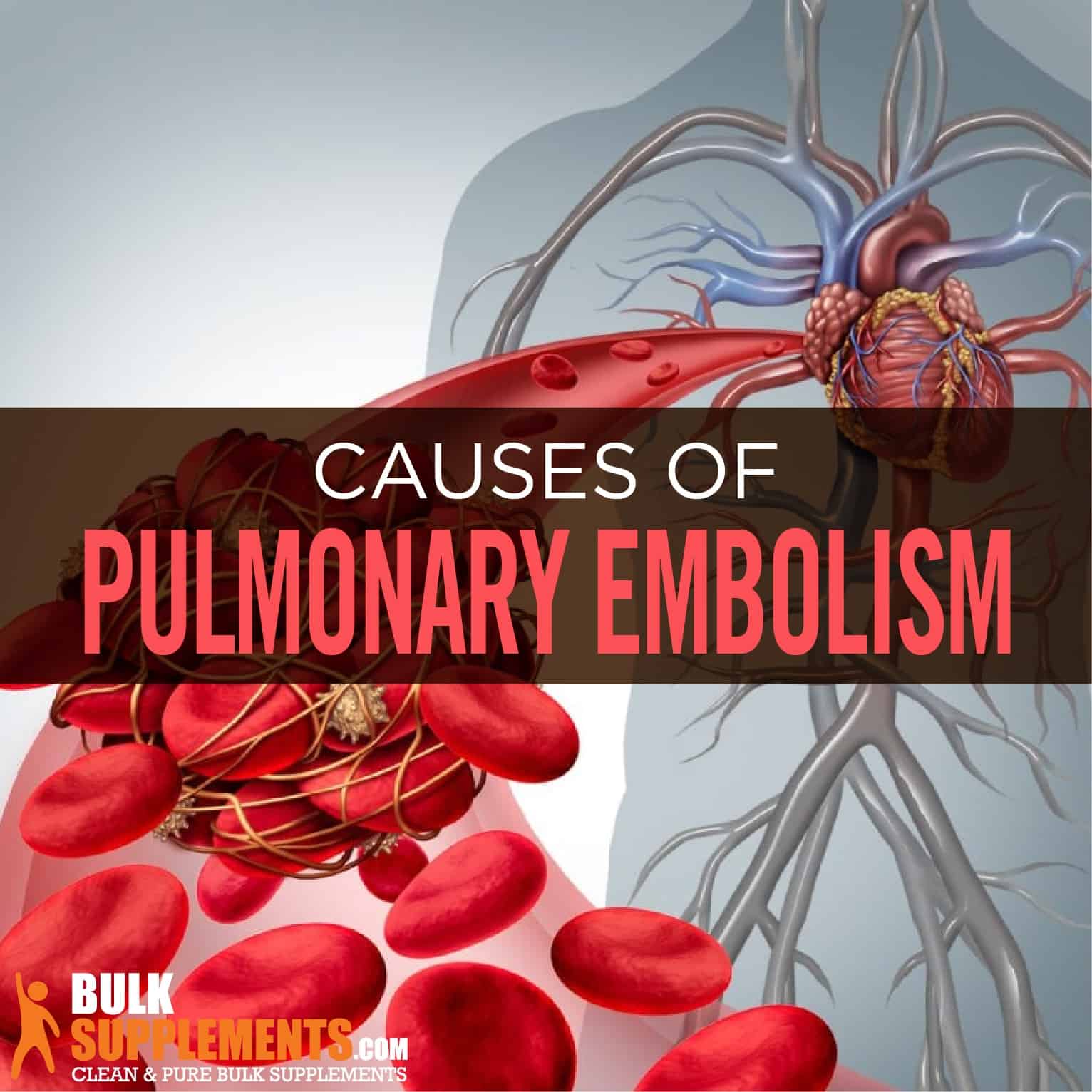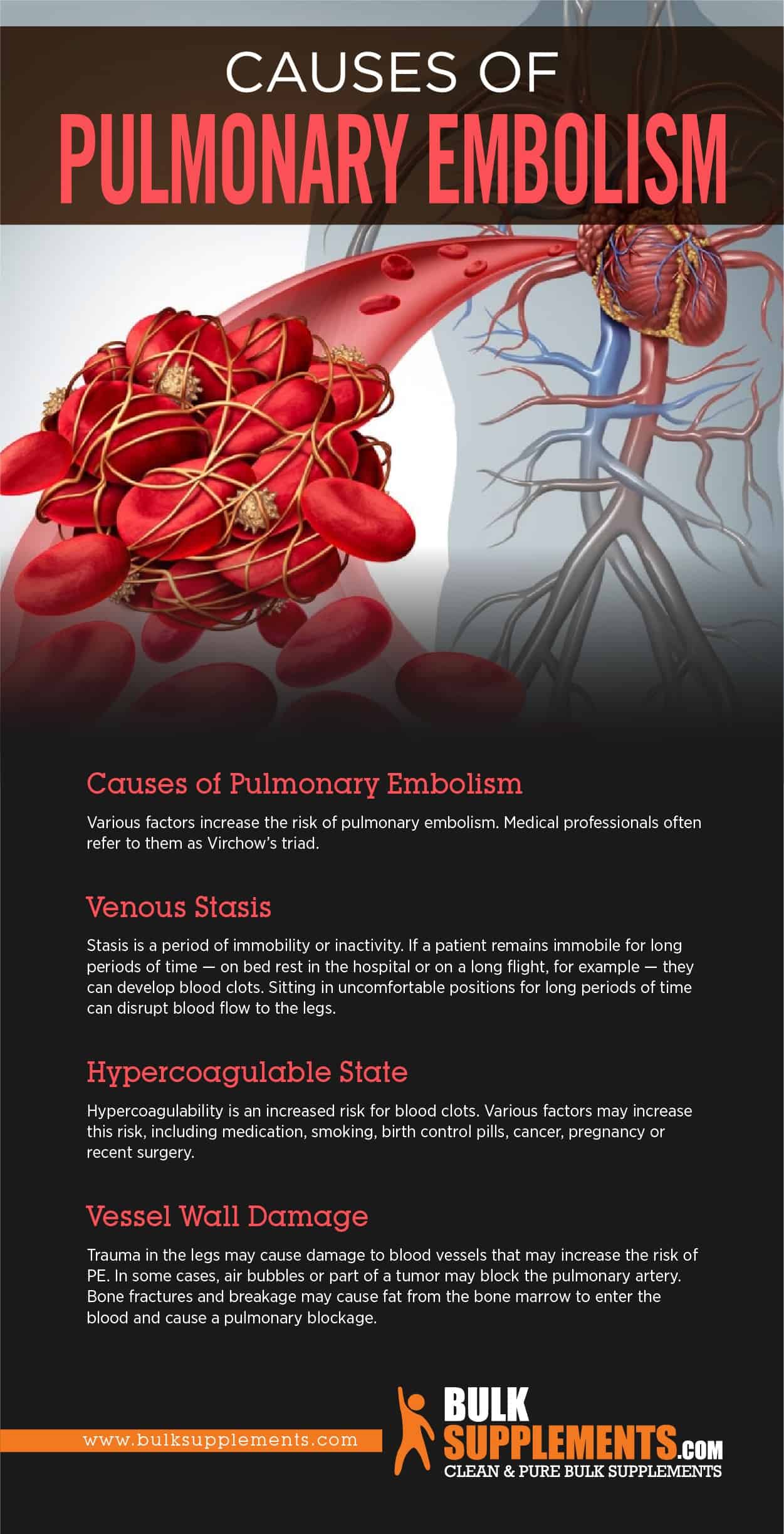Pulmonary Embolism: Causes, Symptoms & Treatment
by James Denlinger Digital Marketing Strategist
What is Pulmonary Embolism?
A blood clot in a major artery in the lungs causes a pulmonary embolism (PE). The blood clot usually forms in the legs. Fortunately, prompt medical attention can help to minimize the risk of serious complications or death. The pulmonary artery is the primary conduit that moves blood from the heart to the lungs. Once the blood reaches the lungs, it is oxygenated before it goes back to the heart, which then pumps the oxygen-rich blood to the rest of the body. When a blood clot blocks the pulmonary artery, it prevents normal blood flow from the lungs to the heart and vice versa.
This condition can cause severe complications, including lung damage and low oxygen levels in the blood. Insufficient oxygen levels can also harm other organs. In addition, pulmonary embolism can be fatal if the clot is large or if there are more than one of them in the artery. Patients can prevent pulmonary embolism by taking steps to prevent blood clots from forming in the legs.
Symptoms of Pulmonary Embolism
Symptoms depend on the size of the blood clot and the part of the lungs it impacts. In addition, the symptoms may worsen if the patient has a lung or cardiac disease. The symptoms of this condition can manifest very quickly.
- Chest pain
- Shortness of breath
- Anxiety
- Coughing, sometimes coughing up blood
- Excessive sweating
- Dizziness & fainting
- Blue lips and/or fingernails
Symptoms of Deep Vein Thrombosis
Patients may also have symptoms of deep vein thrombosis, which is a common cause of pulmonary embolism. This occurs when a blood clot forms in a deep vein in the legs. Deep vein thrombosis develops if the clot breaks off and travels to the lungs. Patients may feel swelling, pain or tenderness in the arms and legs, especially from walking or standing. The swollen limbs may feel warm with discolored skin and abnormally large veins.
Complications of Pulmonary Embolism
PE disrupts blood flow that can damage lung tissue and other organs in the body. It can cause life-threatening complications, especially if the patient has large or multiple blood clots. Complications include cardiac arrest, shock, pulmonary infarction, pulmonary hypertension or paradoxical embolism.
Causes of Pulmonary Embolism
Various factors increase the risk of pulmonary embolism. Medical professionals often refer to them as Virchow’s triad.
Venous Stasis
Stasis is a period of immobility or inactivity. If a patient remains immobile for long periods of time — on bed rest in the hospital or on a long flight, for example — they can develop blood clots. Sitting in uncomfortable positions for long periods of time can disrupt blood flow to the legs (x).
Hypercoagulable State
Hypercoagulability is an increased risk for blood clots. Various factors may increase this risk, including medication, smoking, birth control pills, cancer, pregnancy or recent surgery.
Vessel Wall Damage
Trauma in the legs may cause damage to blood vessels that may increase the risk of PE. In some cases, air bubbles or part of a tumor may block the pulmonary artery. Bone fractures and breakage may cause fat from the bone marrow to enter the blood and cause a pulmonary blockage.

Diagnosing Pulmonary Embolism
Patients who suspect they may have PE should seek immediate medical attention for a diagnosis. First, the physician will perform a physical exam on the legs for signs of swelling, tenderness or discoloration. The doctor will screen the patient for physical signs of deep vein thrombosis.
The doctor may recommend additional tests such as an X-ray, blood test or ultrasound. A blood test is a reliable tool for diagnosing pulmonary embolism because it measures oxygen and carbon dioxide levels in the blood. It can also help physicians detect a substance called D-dimer, a protein fragment that is usually present in the blood if the patient has a blood clot.
CPTE
A CTPE is a form of X-ray that physicians often use to diagnose PE. The physician injects a special dye into the veins to view blood vessels in the lungs in an X-ray.
Ventilation-Perfusion Scan
If a CTPE is unavailable, doctors may recommend a ventilation-perfusion scan. This test uses radioactive material to measure ventilation and perfusion in the lungs. The physician examines where air is flowing to the lungs (ventilation) and where it is not flowing (perfusion). If an area of the lungs has normal airflow but low blood flow, there may be a blood clot.
Pulmonary Angiography
According to physicians, pulmonary angiography is the most accurate test for diagnosing PE. It usually produces conclusive results when other tests do not. In this procedure, a specialist uses a catheter to inject a special dye through a major artery in the legs. Then an X-ray provides images of the inside of the lungs.
Other Tests
Some tests may be harmful for pregnant patients, so doctors may use an MRI to diagnose pulmonary embolism. Finally, an echocardiogram is an ultrasound on the heart. Although it does not necessarily detect PE, it can show strains in the heart that may be the result of pulmonary embolism.
Pulmonary Embolism Treatment
Pulmonary embolism is a severe condition that can be life-threatening. Fortunately, the patient’s chance of recovery is greater with early diagnosis and treatment. There are various treatment options for PE, including:
Anticoagulants
Anticoagulants — blood thinners — are a common treatment for PE. They do not actually thin the blood, but they can prevent blood clots from getting bigger and prevent new clots from forming. If the blood clots do not grow, it gives the body a chance to absorb them.
Warfarin and heparin are two oral blood thinners that may help with PE. Warfarin is a blood thinner that can treat and prevent blood clots. On the other hand, heparin helps minimize additional blood clots from forming. However, blood thinners may cause abnormal bleeding.
Thrombolytics
Contrary to blood thinners, thrombolytics are called “clot busters.” In severe cases, physicians might recommend these drugs to break up blood clots. However, this is usually a last resort treatment because it may increase the risk of bleeding.
Inferior Vena Cava Filter
If the patient cannot use blood thinners or if they are not successful, a doctor may recommend an inferior vena cava filter. The inferior vena cava is a large vein that transfers blood to the heart and the filter is designed to catch blood clots before they get to the lungs.
Surgery
Some cases may require surgery to remove the blood clot. There are two types of procedures for PE: thrombectomy and embolectomy. Doctors use thrombectomy to remove blood clots in patients with deep vein thrombosis. However, embolectomy aims relieve blood clots in the lungs from pulmonary embolism.
Supplements for Heart Health
Patients may also take natural supplements to increase overall health and prevent illness. However, supplements are not a cure for pulmonary embolism or any other medical condition. Instead, they aim to support overall health. Consult a doctor before taking supplements because they may cause side effects or interact with medications.
Ginger Root
Ginger root has several potential effects on the body. It stimulates digestion and supports liver, heart, stomach and spleen function. It can help detoxify the body, clear toxins from the liver and stimulate digestion in the gut. Patients may also use ginger to ease nausea and stomach pain. Ginger may also promote cardiac, joint and metabolic health. It also has antioxidant and anti-inflammatory properties that fight damage in the body. Ginger may also help patients with high blood pressure, supporting healthy circulation and reducing the risk of heart problems. As a dietary supplement, the recommended dosage for ginger root extract powder is 1,000 mg. Take it with water to avoid heartburn. Consult a doctor before taking this supplement, especially patients with diabetes.
Garlic
Because of its distinct taste and aroma, garlic is a popular ingredient for cooking. But it can also promote overall health and well being. It is a natural antioxidant that helps support the immune system. Research states that it can also promote a healthy cardiovascular system for healthy circulation. Garlic may help patients with hypertension and possibly even prevent it. The recommended dosage for garlic extract powder is 650 mg twice a day with meals. Consult a doctor before taking this supplement. It can help prevent blood clots, but it may also interfere with blood thinning medications.
Ginkgo Biloba Leaf
Ginkgo biloba leaf has antioxidant and anti-inflammatory properties that may help promote cardiac, digestive and bone and joint health. Research claims that it may even help with memory, depression and anxiety. Ginkgo biloba is also a part of traditional Chinese medicine to address respiratory conditions and improve blood flow. The recommended serving size for ginkgo biloba leaf extract powder is 175 mg three times a day. However, do not exceed 525 mg per day. Consult a physician before taking this supplement.
N-Acetyl L-Cysteine
N-acetyl L-cysteine (NAC) is a form of cysteine with several different health benefits. It can help produce antioxidants in the body, especially paired with glutamine and glycine to replace glutathione, which helps fight free radical damage. Research claims that it can help with mental health, including obsessive compulsive disorder (OCD), schizophrenia, depression and bipolar disorder. It may even help reduce the risk for stroke or heart attack. The recommended dosage for N-Acetyl L-Cysteine (NAC) is 600 mg up to three times a day. However, consult a physician beforehand if you use medications for diabetes or heart problems.
L-Arginine
L-arginine is an important amino acid. It is present naturally in red meat, poultry, fish, eggs and dairy, but researchers also develop it into dietary supplements. In the body, L-arginine converts to nitric oxide, which improves blood circulation. Insufficient nitric oxide can increase the risk for heart disease. In addition, L-arginine may help patients with coronary artery disease. As a dietary supplement, the recommended dosage for L-arginine base powder is 500 mg one to three times a day. In its capsule form, the recommended dosage is one capsule up to three times a day on an empty stomach. Consult a doctor before adding this supplement to a dietary regimen.
The Bottom Line
If a patient develops a blood clot in a major artery, such as the legs, it can cause pulmonary embolism. The pulmonary artery is the main transport that brings blood from the heart to the lungs and then it flows back to the heart to distribute to the rest of the body. However, if a patient develops a blood clot that blocks the artery, it disrupts blood flow between the heart and the lungs.
Pulmonary embolism can be fatal, causing lung damage and low oxygen levels in the blood. Patients may experience abnormal heart rhythms, pulmonary hypertension, cardiac arrest and sudden death. Symptoms include abnormally large veins in the arms or legs, chest pain and shortness of breath. Patients may develop blood clots from vessel wall damage, venous stasis or if their risk for blood clots is high from recent surgery.
PE is treatable if the patient receives early diagnosis and treatment from anticoagulants, thrombolytics, inferior vena cava filter or surgical procedures. Patients may also take supplements to improve blood circulation and support cardiovascular function. However, they are not a cure for pulmonary embolism or any other medical condition. Consult a doctor before taking supplements with PE to ensure safety and avoid medication interactions.
Sponsor Ads
Created on Mar 2nd 2020 22:12. Viewed 220 times.



